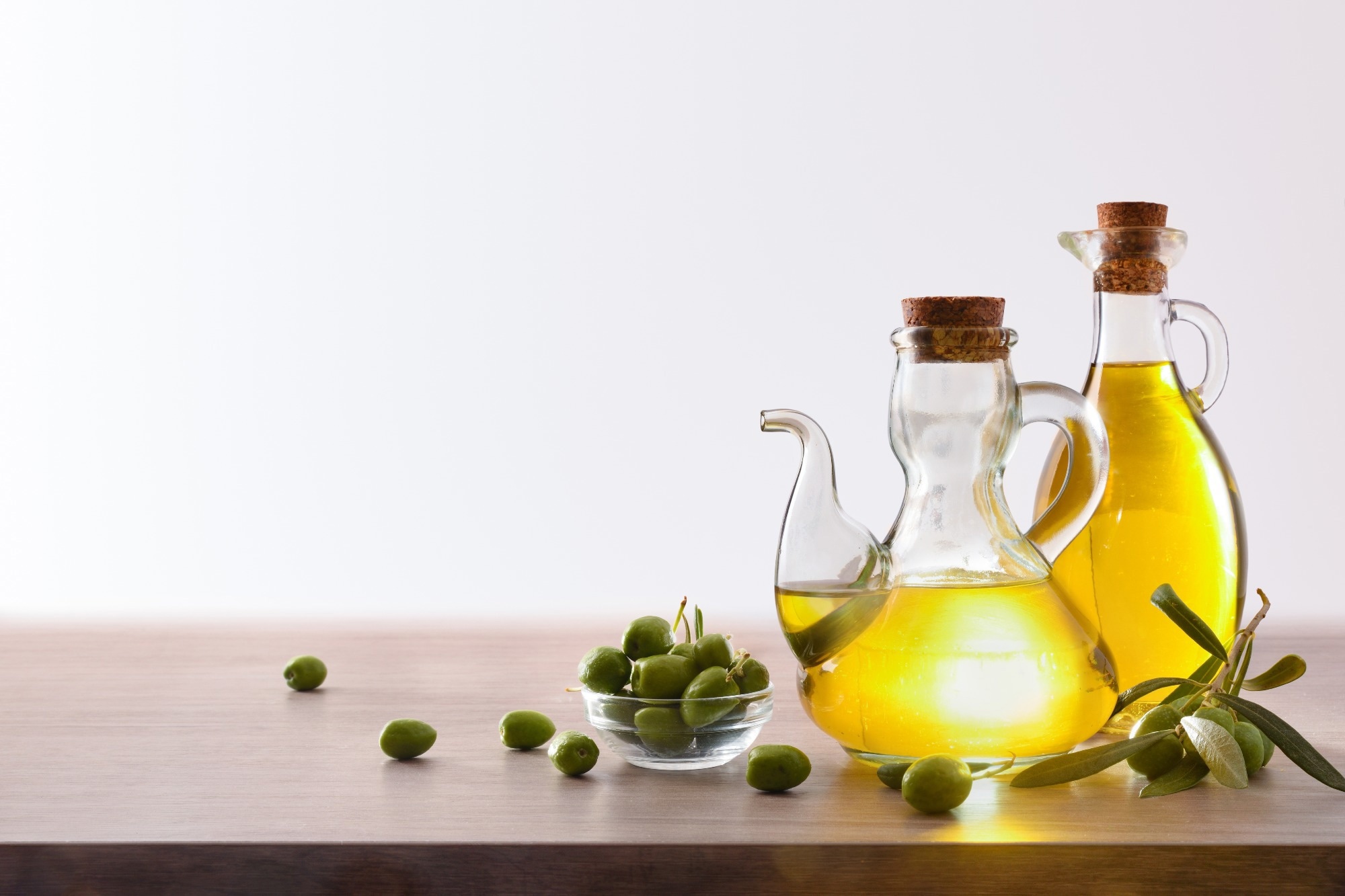Olive oil is a key component of the Mediterranean diet (MD), which is widely recognized as one of the healthiest dietary patterns in the world. A recent Nutrients review summarizes recent evidence on the clinical impact of olive oil on human health.
 Study: Is there more to olive oil than healthy lipids? Image Credit: Davizro Photography / Shutterstock.com
Study: Is there more to olive oil than healthy lipids? Image Credit: Davizro Photography / Shutterstock.com
Introduction
Olive oil is one of the most ancient components of the human diet, with the MD incorporating between 25-50 mL of olive oil every day. Notably, MD is highly correlated with a longer lifespan and lower incidences of chronic diseases.
MD represents a set of traditional practices and knowledge and can be considered as a way of life, rather than just food choices.”
Various grades of olive oil are now available, which include virgin olive oil (VOO), which is obtained by purely mechanical or other means and, as a result, is rich in native bioactive compounds. Extra-VOO (EVOO) comprises an oleic acid concentration of 0.80 g/100 g or less, thus representing the highest quality type of olive oil. In contrast, VOO may include up to 2.0 g/100 g oleic acid.
Nutritionally, OO primarily consists of monounsaturated fatty acids (MUFAs), especially oleic acid and palmitoleic acid, which comprise 55-87% of the oil. Polyunsaturated fatty acids (PUFA) comprise about 3.5-21%, including linoleic and linolenic acids. Saturated fat comprises 8-25% of OO in the form of myristic, palmitic, and stearic acids.
Polyphenols such as sterols, terpenoids, squalenes, pigments, tocoferols, and polar phenols comprise between 1-2% of OO. VOO consumption correlates with the levels of hydroxytyrosol oleuropein and oleic acid.
The current review examines recent studies published between October 2016 and December 2022 to identify associations between OO consumption and the incidence of various health conditions.
What did the study show?
Lifestyle conditions such as obesity, diabetes, cardiovascular disease (CVD), neurodegenerative conditions, inflammation, endothelial function, lipid levels, antioxidant levels, and the gut microbiota can be improved by the consumption of olive oil.
The benefits of olive oil appear to be related to its unique composition, particularly its high concentrations of MUFA. Other important compounds include polyphenols such as oleuropein and hydroxytyrosol; however, the exact association between specific components and metabolic effects is not clear.
Diets low in fats other than OO that are accompanied by an increased intake of plant-based foods and low consumption of meat were associated with reduced weight, lower liver enzymes and serum lipids, and lower fat deposition in the liver. Each of these factors reduces cardiovascular and fatty liver risk factors while supporting muscle strength. EVOO may also increase the activity of metabolically active brown fat.
Furthermore, EVOO has been shown to regulate inflammation and insulin secretion when used as part of a healthy diet. However, EVOO alone is not associated with significant effects on weight gain or serum cholesterol levels in healthy individuals when compared with rice bran oil or palm oil.
Butter did increase non-high-density lipoprotein (HDL) levels, whereas coconut oil increased HDL levels. Nevertheless, neither type of fat product increased other metabolic markers, body weight, or fat distribution as compared to EVOO.
Dietary MUFA, which is achieved through the consumption of OO enriched with oleanolic acid (OA), can decrease liver fat deposition with better insulin sensitivity in both the liver and at systemic level.
The combined action of MUFA and polyphenol components on different metabolic pathways may contribute positively to control lipid metabolism, favor good glycemic control, and ensure good anti-inflammatory activity.”
OO supplementation is associated with reduced blood pressure levels and sympathetic activation. Anti-thrombotic and pro-endothelial benefits have also been associated with OO, which are likely due to the natural antioxidant activity of OO that prevents or reduces inflammation associated with oxidative stress.
The prevention of dyslipidemia coupled with potentially anti-inflammatory effects of olive oil could reduce the risk of CVD, including coronary heart disease (CHD), in healthy adults as compared to mayonnaise, butter, dairy fat, or margarine. Notably, these effects are more evident in those at high risk for cardiometabolic disease.
The positive effects of OO on diet quality also extend to its potential ability to protect against neurodegenerative disease. Cognitive functions among the elderly, increased attention span, and preservation of the integrity of the blood-brain barrier are other beneficial effects of OO that are primarily due to its bioactive phenolics.
OO, a completely natural product, can be used in clinical protocols as complementary treatment of cognitive impairments, anxiety, and depression.”
OO supplementation also supports a healthy gut microbiota profile and, as a result, could improve the treatment of inflammatory bowel disorders and reduce symptoms like bloating and incomplete defection in these patients.
What are the implications?
Due to its disease-preventing effects, OO is considered a functional food.”
The European Food Safety Authority has approved the advertisement of olive oil in this respect, with recommendations that individuals consume at least 20 g daily to experience the benefits. Furthermore, OO products must contain at least 5 mg of hydroxytyrosol and related compounds per 20 g.
Standardization of research and reporting methods is essential for obtaining definitive evidence of the utility of OO in human health, given the contradictory results from multiple studies. Thus, future research is needed to understand and perhaps potentiate the mechanisms by which OO improves health outcomes and prevents certain diseases.
Journal reference:
- Isaakadis, A., El Maghariki, J., Carvalho-Barros, S., et al. (2023). Is there more to olive oil than healthy lipids? Nutrients. doi:10.3390/nu15163625.